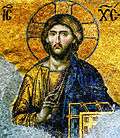Dyophysite
| Part of a series on |
| Eastern Christianity |
|---|
 |
|
Liturgy and worship |
|
Dyophysite (/daɪˈɒfəˌsaɪt/; Greek: δυοφυσῖται) is a theological term used in understanding how the divine and human are related in the person of Jesus Christ, an area of study known as Christology. The term comes from the Greek and literally means "two natures." Two natures refer to a human nature and a divine nature that exist in the one person of Jesus.
Dyophysite describes the position of the Council of Chalcedon (AD 451). The term was primarily used by those who rejected the Chalcedonian position, in contrast to their own Christology which was arguably either Monophysite (that is, Christ had one nature that was divine) or Miaphysite (that is, Christ was both divine and human in one nature). The Oriental Orthodox tradition, including the Copts, considered themselves to be Miaphysites.
Dyophysite has also been used to describe Nestorianism, the doctrine ascribed to the Patriarch Nestorius of Constantinople by his detractors. His detractors falsely asserted that he believed that Christ existed as two persons (hypostases): the human Jesus and the divine Logos. The use of it to describe those who supported the Chalcedonian position (who continued on as the Roman Catholic and Eastern Orthodox Churches) could be considered as equivalent to accusing them of being Nestorian, which they were not as they emphasised the complete and perfect unity of the two natures in one hypostasis. For the Chalcedonians the hypostasis was the centre of Jesus' unity (his divinity and humanity being described as natures) whereas those who rejected the Chalcedonian definition saw his nature as the point of unity.
Many historical theologians and ecumenists believe it was and continues to be more a difference of terminology than actual belief.
See also
- Church of the East
- Council of Chalcedon
- First Council of Ephesus
- Miaphysitism
- Monophysitism
- Nestorianism
- Oriental Orthodoxy
- Second Council of Constantinople